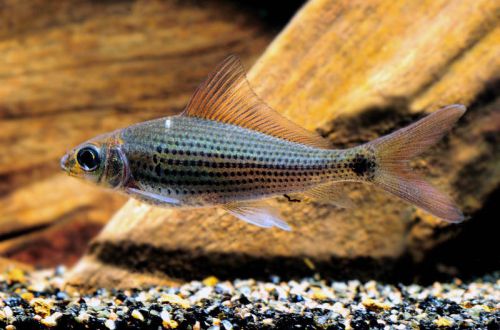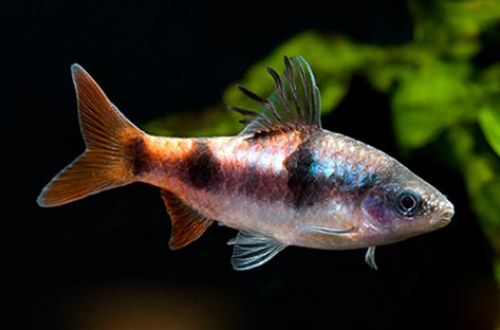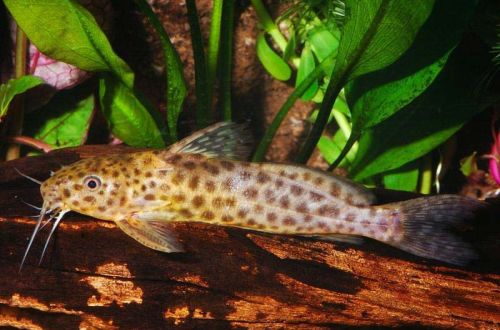
Hard-lipped Barbus
The hard-lipped barb, scientific name Osteochilus hasseltii or Osteochilus vittatus, belongs to the Cyprinidae family. Large active fish, has several subspecies, differing from each other in the color of the caudal fin. In Asia, it is often used as a commercial fish. Unpretentious and easy to maintain, however, the large size of adults limits its distribution among amateur aquarists.

Contents
Habitat
The natural habitat extends over most of Southeast Asia through the territory of such modern states as Thailand, Laos, Cambodia, Vietnam, and is also found on the islands of Borneo, Sumatra and Java. It lives in many large and medium-sized rivers, lakes and reservoirs, prefers a region with a slow flow and soft substrate. During the rainy season, they migrate to flooded areas of tropical forests for spawning.
Brief information:
- The volume of the aquarium – from 680 liters.
- Temperature – 22-25°C
- Value pH — 6.0–8.0
- Water hardness – soft (5-12dGH)
- Substrate type – sandy
- Lighting – subdued
- Brackish water – no
- Water movement – weak current or still water
- The size of the fish is up to 30 cm.
- Nutrition – any sinking food with herbal supplements
- Temperament – peaceful active fish
- Keeping in a flock of 5 individuals
Description
Adults reach about 30 cm in length. Males and females are practically indistinguishable from each other. The coloration is silvery with black dots arranged in horizontal lines stretching from head to tail. The tail is translucent or reddish, depending on the specific subspecies.
Food
An omnivorous species, gladly accepts all types of dry, frozen and live foods with herbal supplements, the main condition is that they must be sinking, and not floating on the surface. In search of food, it constantly breaks the bottom and can damage the roots of plants and eat shoots with soft tender leaves. Feed two or three times a day in the amount eaten in 5 minutes.
Maintenance and care, arrangement of the aquarium
You will need a large tank of at least 600 liters. The hard-lipped Barb prefers dim lighting, so in addition to a low power lighting system, it is recommended to use floating plants, they create additional shading. The substrate is soft sandy, large snags, roots and branches of trees are installed as a decor at the bottom. Root plants should not be planted directly into the ground, for these purposes special pots are used, which are then immersed in the substrate.
The set of equipment consists of a filtration system to match the size of the tank, an aerator, heaters and a combination of lamps.
The water conditions are characterized by a weak internal flow, low content of dissolved calcium and magnesium salts (dGH index), the pH index is maintained in the region of the neutral mark. More about pH and dGH parameters in the section “Hydrochemical composition of water”.
Aquarium maintenance consists in weekly replacement of part of the water (20–25% of the volume) with fresh water, regular cleaning of the substrate from organic waste and removal of plaque from the glass.
Behavior and Compatibility
Despite their size, adult fish are quite shy and can be easily intimidated by small but aggressive species. Compatible with other moving fish of similar or slightly smaller size. Very small neighbors in the aquarium can become accidentally prey, so you should not add them to these giants.
The hard-lipped Barb belongs to schooling species, a peculiar hierarchy of dominant and subdominant individuals is formed within the community, therefore fish should always be kept in a group of at least 5 individuals, otherwise aggression towards other species is possible.
Breeding / breeding
Commercially bred in special fish farms in Southeast Asia. Playback at home is almost impossible.
Fish diseases
Exceptionally hardy look. Possible health problems in most cases are directly related to unsuitable living conditions and / or poor quality food. In the event of a disease, first of all, you should check the parameters and quality of water, if necessary, bring them back to normal, and only then proceed with treatment. Read more about symptoms and treatments in the Aquarium Fish Diseases section.





